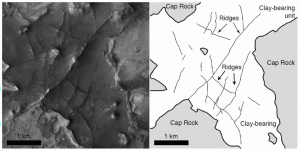Water seeping through conduits and cracks in the deep subsurface rocks of Nilosyrtis and Nili Fossae left behind minerals, like hard-water deposits that collect in the plumbing of your house. (Or cholesterol in your arteries.) Then as the softer rocks around them eroded over millions of years, the mineralized seams emerged as ridges.

PROMINENT VEINS. Ridges in Nili Fossae stand out as ridges because groundwater containing minerals flowed into cracks and left hard deposits. As surrounding rocks weathered away, the mineralized veins emerged as ridges. (Image taken from Figure 2 in the paper.)
The ridges had been noted before by scientists, but their origin was unexplained, largely because sufficiently sharp images didn’t exist. Lee Saper and Jack Mustard (both Brown University) used new, more detailed imagery to explore the ridges and their surroundings. Their work is described in a Geophysical Research Letters paper which lays out the evidence for a mineralizing flow of subsurface water in early times.
Such a flow would strengthen the argument that ancient Mars had an active underground hydrology, possibly including habitats for life.
The new imagery came from the Context Camera (CTX) and the High-Resolution Imaging Science Experiment (HiRISE) on NASA’s Mars Reconnaissance Orbiter. In all, the scientists mapped more than 4,000 ridge segments in the two areas.
Mineral veins are not unknown on Mars. The researchers note in particular that Mars Exploration Rover Opportunity discovered a vein of water-precipitated gypsum cutting through ancient shattered rocks on the rim of Endeavour Crater. They also noted that Nili Fossae lies near the rim of the Isidis impact basin. The ridges in Nili, the scientists found, have orientations that suggest influence by the basin-making impact, either the original shock or subsequent faulting and collapse on its margins.
“This suggests that fracture formation resulted from the energy of localized impact events,” says Saper. In the case of Nilosyrtis, which lies farther from Isidis, the ridged unit lies in the floors of large impact craters, again suggesting a shock-related origin.
Another piece of evidence pointing to water being abundantly present in ancient times is that in the areas studied, the ridges occur only among rocks that contain iron-magnesium clays, typically produced when water is present.
“The association with these hydrated materials suggests there was a water source available,” explains Saper. “That water would have flowed along the path of least resistance, which in this case would have been these fracture conduits.”
To judge from the density of the ridge network, Saper says, “there was enough fracturing and fluid flow in the crust to sustain at least a regional subsurface hydrology.” Given the importance of water to the search for life on Mars, he says, “if in fact these fractures that turned into ridges were flowing with hydrothermal fluid, they could have been a viable biosphere.”
Nili Fossae was once a candidate landing site for Curiosity, the Mars Exploration Rover. In the end NASA chose Gale Crater instead. But Saper notes that something similar could well turn up in Gale.
“In Gale Crater, we think there are mineralized fractures that Curiosity will go up and touch,” Saper says. “These are very small and may not be exactly the same kind of feature we studied in Nili and Nilosyrtis. But we’ll have the opportunity to crush them up and do chemical analysis on them. That could either bolster this hypothesis – or tell us we need to explore other possibilities.”








